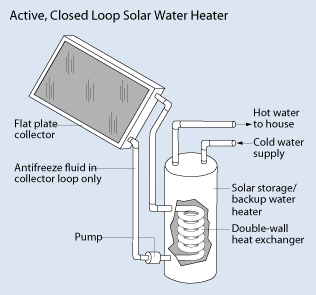 Solar water heaters use the sun's heat to provide hot water for a home or building.
Solar water heaters use the sun's heat to provide hot water for a home or building.
How Solar Water Heaters Work
Solar water heating systems include storage tanks and solar collectors. Solar water heaters use the sun to heat either water or a heat-transfer fluid in the collector.
Most solar water heaters require a well-insulated storage tank. The tank can be a modified standard water heater, but it is usually larger and very well insulated. Solar storage tanks have an additional outlet and inlet connected to and from the collector.
In two-tank systems, the solar water heater preheats water before it enters the conventional water heater. In one-tank systems, the back-up heater is combined with the solar storage in one tank.
Types of Solar Collectors
Solar collectors gather the sun's energy, transform its radiation into heat, and then transfer that heat to water or solar fluid. Three types of solar collectors are used in solar water heating systems:
Flat-plate collectors
A typical flat-plate collector is an insulated metal box with a glass or plastic cover (called the glazing) and a dark-colored absorber plate. Unglazed flat-plate collectors—typically used for solar pool heating—have a dark absorber plate, made of metal or polymer, without a cover or enclosure.
Integral collector-storage systems
Integral collector-storage systems, also known as ICS or "batch" systems, are made of one or more black tanks or tubes in an insulated glazed box. Cold water first passes through the solar collector, which preheats the water, and then continues to the conventional backup water heater.
Evacuated-tube solar collectors
Evacuated-tube collectors can achieve extremely high temperatures (170°F to 350°F), making them more appropriate for cooling applications and commercial and industrial application. The collectors are usually made of parallel rows of transparent glass tubes. Each tube contains a glass outer tube and metal absorber tube attached to a fin. The fin is covered with a coating that absorbs solar energy well, but which inhibits radiative heat loss. Air is removed, or evacuated, from the space between the two glass tubes to form a vacuum, which eliminates conductive and convective heat loss.
Types of Solar Water Heating Systems
There are two types of solar water heating systems: active, which have circulating pumps and controls, and passive, which don't.
Active Solar Water Heating Systems
There are two types of active solar water heating systems:
Direct circulation systems
Direct-circulation systems use pumps to circulate pressurized potable water directly through the collectors. These systems are appropriate in areas that do not freeze for long periods and do not have hard or acidic water.
Indirect circulation systems
Indirect-circulation systems pump heat-transfer fluids through collectors. Heat exchangers transfer the heat from the fluid to the potable water. They are popular in climates prone to freezing temperatures. Some indirect systems have "overheat protection," which is a means to protect the collector and the glycol fluid from becoming super-heated when the load is low and the intensity of incoming solar radiation is high. The two most common indirect systems are:
- Antifreeze. The heat transfer fluid is usually a glycol-water mixture with the glycol concentration depending on the expected minimum temperature. The glycol is usually food-grade propylene glycol because it is non-toxic.
- Drainback systems, which use pumps to circulate water through the collectors. The water in the collector loop drains into a reservoir tank when the pumps stop. This makes drainback systems a good choice in colder climates. Drainback systems must be carefully installed to assure that the piping always slopes downward, so that the water will completely drain from the piping.
 Passive solar water heaters rely on gravity and the tendency for water to naturally circulate as it is heated. There are two basic types of passive systems:
Passive solar water heaters rely on gravity and the tendency for water to naturally circulate as it is heated. There are two basic types of passive systems:
Integral collector-storage passive systems
Integral-collector storage systems consist of one or more storage tanks placed in an insulated box with a glazed side facing the sun. These work best in areas where temperatures rarely fall below freezing. They also work well in households with significant daytime and evening hot-water needs. They do not work well in homes or buildings with predominantly morning draws because they lose most of the collected energy overnight.
Thermosyphon systems
Thermosyphon systems rely on the natural convection of warm water rising to circulate water through the collectors and to the tank (located above the collector). As water in the solar collector heats, it becomes lighter and rises naturally into the tank above. Meanwhile, the cooler water flows down the pipes to the bottom of the collector, enhancing the circulation. Some manufacturers place the storage tank in the house's attic, concealing it from view. Indirect thermosyphons (that use a glycol fluid in the collector loop) can be installed in freeze-prone climates if the piping in the unconditioned space is adequately protected.
Backup Systems
Solar water heating systems almost always require a backup system for cloudy days and times of increased demand. Conventional storage water heaters usually provide backup and may already be part of the solar system package. A backup system may also be part of the solar collector, such as rooftop tanks with thermosyphon systems.
Since an integral-collector storage system already stores hot water in addition to collecting solar heat, it may be packaged with a demand (tankless or instantaneous) water heater for backup.
More Information
Visit the Energy Saver website for more information about the following topics:
- Components, selection, installation, and maintenance of residential solar water heaters
- Economics of solar water heating systems for homes
- Energy-efficient water heating strategies for homes.

